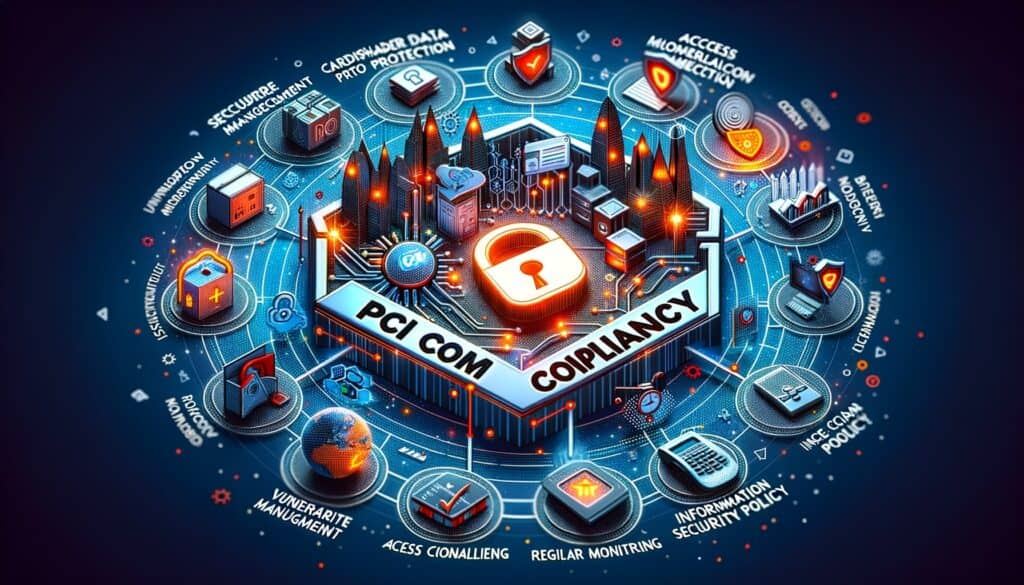
By admin October 10, 2024
In today’s digital age, where online transactions have become the norm, ensuring the security of sensitive customer information is of utmost importance. This is where PCI compliance comes into play. PCI compliance, short for Payment Card Industry Data Security Standard compliance, is a set of security standards established by major credit card companies to protect cardholder data and prevent fraud.
In this article, we will delve into the world of PCI compliance, exploring its importance for businesses, the framework it operates on, key requirements for achieving compliance, steps to achieve and maintain compliance, common challenges and pitfalls, benefits for businesses and consumers, and address frequently asked questions.
The Importance of PCI Compliance for Businesses
The importance of PCI compliance for businesses cannot be overstated. With the increasing number of data breaches and cyberattacks, businesses that handle credit card information are at a higher risk of being targeted by hackers. Non-compliance with PCI standards not only puts customer data at risk but also exposes businesses to severe financial and reputational damage.
By achieving and maintaining PCI compliance, businesses can demonstrate their commitment to protecting customer data, build trust with their customers, and avoid costly penalties and legal consequences.
The PCI DSS Framework: Explained in Detail

The PCI DSS framework serves as the foundation for achieving PCI compliance. It consists of twelve requirements that businesses must adhere to in order to protect cardholder data. These requirements cover various aspects of data security, including network security, access control, encryption, and regular monitoring. Let’s take a closer look at each requirement:
- Install and maintain a firewall configuration to protect cardholder data: Businesses must have a robust firewall in place to secure their network and prevent unauthorized access.
- Do not use vendor-supplied defaults for system passwords and other security parameters: Default passwords are easy targets for hackers. Businesses must change default passwords and use strong, unique passwords to protect their systems.
- Protect stored cardholder data: Businesses must encrypt cardholder data when it is stored to prevent unauthorized access in case of a data breach.
- Encrypt transmission of cardholder data across open, public networks: When transmitting cardholder data over the internet, businesses must use encryption to ensure its confidentiality and integrity.
- Use and regularly update anti-virus software or programs: Anti-virus software helps detect and remove malicious software that can compromise the security of cardholder data.
- Develop and maintain secure systems and applications: Businesses must implement secure coding practices and regularly update their systems and applications to address vulnerabilities.
- Restrict access to cardholder data by business need-to-know: Access to cardholder data should be limited to authorized personnel who need it to perform their job responsibilities.
- Assign a unique ID to each person with computer access: Unique user IDs help track and monitor access to cardholder data, reducing the risk of unauthorized access.
- Restrict physical access to cardholder data: Physical access to areas where cardholder data is stored should be restricted to authorized personnel only.
- Track and monitor all access to network resources and cardholder data: Businesses must implement logging mechanisms to track and monitor access to cardholder data, enabling them to detect and respond to any suspicious activity.
- Regularly test security systems and processes: Regular security testing helps identify vulnerabilities and weaknesses in systems and processes, allowing businesses to address them promptly.
- Maintain a policy that addresses information security for all personnel: Businesses must have a comprehensive information security policy that outlines the responsibilities and expectations of all personnel regarding the protection of cardholder data.
Key Requirements for Achieving PCI Compliance

To achieve PCI compliance, businesses must meet all twelve requirements outlined in the PCI DSS framework. However, it is important to note that compliance is not a one-time event but an ongoing process. Here are the key requirements for achieving and maintaining PCI compliance:
- Conduct a thorough assessment of your current security measures: Before embarking on the journey towards PCI compliance, businesses should conduct a comprehensive assessment of their current security measures to identify any gaps or vulnerabilities.
- Implement necessary security controls: Based on the assessment, businesses should implement the necessary security controls to address any identified gaps and vulnerabilities. This may include upgrading hardware and software, implementing encryption protocols, and establishing access controls.
- Regularly monitor and test security systems: Compliance is not a static state but requires continuous monitoring and testing of security systems. Regularly monitoring and testing systems helps identify any potential weaknesses or breaches and allows for timely remediation.
- Develop and maintain a security policy: A well-defined and documented security policy is essential for achieving and maintaining PCI compliance. This policy should outline the responsibilities and expectations of all personnel regarding the protection of cardholder data.
- Train employees on security best practices: Employees play a crucial role in maintaining the security of cardholder data. Businesses should provide regular training to employees on security best practices, including password hygiene, phishing awareness, and data handling procedures.
- Engage with a Qualified Security Assessor (QSA): A QSA is an independent third-party organization that assesses businesses’ compliance with PCI standards. Engaging with a QSA can provide businesses with expert guidance and validation of their compliance efforts.
Steps to Achieve and Maintain PCI Compliance
Achieving and maintaining PCI compliance requires a systematic approach. Here are the steps businesses can follow to ensure compliance:
- Determine your level of compliance: PCI compliance requirements vary based on the volume of transactions a business processes. Businesses should determine their level of compliance (Level 1, 2, 3, or 4) to understand the specific requirements they need to meet.
- Conduct a self-assessment questionnaire (SAQ): The PCI Security Standards Council provides self-assessment questionnaires tailored to different types of businesses. Completing the appropriate SAQ helps businesses assess their compliance with PCI standards.
- Perform vulnerability scans: Vulnerability scans help identify any weaknesses or vulnerabilities in a business’s systems. Businesses should conduct regular vulnerability scans and address any identified issues promptly.
- Implement necessary security controls: Based on the results of the self-assessment questionnaire and vulnerability scans, businesses should implement the necessary security controls to address any identified gaps or vulnerabilities.
- Engage with a Qualified Security Assessor (QSA): For businesses that fall under Level 1 compliance, engaging with a QSA is mandatory. A QSA will conduct an independent assessment of a business’s compliance efforts and provide a Report on Compliance (ROC) if the business meets all requirements.
- Submit compliance documentation: Businesses are required to submit compliance documentation to their acquiring bank or payment processor. This documentation may include the SAQ, vulnerability scan reports, and the ROC (if applicable).
- Maintain ongoing compliance: Compliance is not a one-time event but an ongoing process. Businesses must continuously monitor and test their security systems, update their security policies, and train employees on security best practices to maintain compliance.
Common Challenges and Pitfalls in PCI Compliance

Achieving and maintaining PCI compliance can be challenging for businesses, especially those with limited resources or complex IT infrastructures. Some common challenges and pitfalls in PCI compliance include:
- Lack of awareness and understanding: Many businesses are unaware of the importance of PCI compliance or lack a clear understanding of the requirements. This can lead to non-compliance and increased risk of data breaches.
- Complexity of IT infrastructures: Businesses with complex IT infrastructures may find it challenging to implement the necessary security controls and ensure compliance across all systems and applications.
- Limited resources: Small businesses or those with limited resources may struggle to allocate the necessary time, budget, and personnel to achieve and maintain PCI compliance.
- Non-compliance with specific requirements: Businesses may inadvertently overlook or misunderstand specific requirements, leading to non-compliance. For example, failing to encrypt cardholder data during transmission or using weak passwords can result in non-compliance.
- Lack of regular monitoring and testing: Compliance requires continuous monitoring and testing of security systems. Businesses that fail to regularly monitor and test their systems may miss potential vulnerabilities or breaches.
Benefits of PCI Compliance for Businesses and Consumers
While achieving and maintaining PCI compliance may require effort and resources, the benefits for businesses and consumers are significant. Let’s explore the benefits of PCI compliance:
- Enhanced security: PCI compliance helps businesses implement robust security measures to protect cardholder data, reducing the risk of data breaches and fraud.
- Increased customer trust: By achieving PCI compliance, businesses demonstrate their commitment to protecting customer data, building trust and confidence among their customers.
- Avoidance of financial penalties: Non-compliance with PCI standards can result in significant financial penalties imposed by credit card companies. Achieving and maintaining compliance helps businesses avoid these penalties.
- Protection of reputation: Data breaches can severely damage a business’s reputation. By prioritizing PCI compliance, businesses can protect their reputation and maintain the trust of their customers.
- Competitive advantage: PCI compliance can provide businesses with a competitive advantage. Many customers prioritize security when choosing where to make their online purchases, and being PCI compliant can give businesses an edge over their non-compliant competitors.
Frequently Asked Questions (FAQs)
Q.1: What is PCI compliance?
PCI compliance refers to adherence to the Payment Card Industry Data Security Standard, a set of security standards established by major credit card companies to protect cardholder data and prevent fraud.
Q.2: Who needs to be PCI compliant?
Any business that handles credit card information, regardless of its size or industry, needs to be PCI compliant.
Q.3: What are the consequences of non-compliance with PCI standards?
Non-compliance with PCI standards can result in financial penalties imposed by credit card companies, loss of customer trust, reputational damage, and legal consequences.
Q.4: How often should businesses conduct vulnerability scans?
Businesses should conduct vulnerability scans at least quarterly or whenever significant changes are made to their systems or applications.
Q.5: What is a Qualified Security Assessor (QSA)?
A Qualified Security Assessor (QSA) is an independent third-party organization that assesses businesses’ compliance with PCI standards.
Conclusion
In conclusion, PCI compliance is crucial for businesses that handle credit card information. By adhering to the PCI DSS framework and meeting the key requirements, businesses can protect cardholder data, build trust with their customers, and avoid costly penalties and reputational damage. While achieving and maintaining compliance may present challenges, the benefits for businesses and consumers are significant.
By prioritizing PCI compliance, businesses can enhance security, increase customer trust, and gain a competitive advantage in today’s digital landscape.